#how i felt so often in
Text
hyperfixations are so crazy because you never know whether this next thing you like is going to be a short-term interest or if it's going to change your entire life forever
#thats how it's been for me atleast#it's like flipping a coin every time i get into something new#this was abt splatoon btw lol#anyways it's unlike me to textpost on main but i felt like sharing my thoughts so. heeey#maybe i'll talk here more often idk
11K notes
·
View notes
Text

got an urge to design ponies oops
#If people like this I'll do the rest of the life cast... No cutiemarks though cause Im really bad at those#geminitay fanart#pearlescentmoon fanart#jimmy solidarity#martyn inthelittlewood#scott smajor fanart#zombiecleo fanart#bdubs fanart#ethoslab fanart#impulse fanart#joel smallishbeans#he was difficult lol. I tried all sorts of green + brown (sometimes borderline red) colors but none felt quite right#so I just. made both the body and hair both green and brown. I think theres definitely a better design to be had here but I did my best#ldshadowlady fanart#Impulse ofc mostly inspired from that one skin where he has a beard#seeing people do fan designs for lifers is the only thing that gave me the urge to draw this#I wanted to see how much the colors could be played around with without making the ponies unrecognizable#and also like. pleasant to the eye. Again as if they could fit into the show itself#there arent a lot of skin toned ponies walking around equestria for a reason... it's uncanny unfortunately#that often makes fan ponies all follow the exact scame scheme of light body + dark hair#they get really indistinguishable so go wild!!!! mix things up!!!#sorry Im passionate about animal character design and ponies#tubby art
1K notes
·
View notes
Text
The Real Cost of the Fashion Industry

Atacama Desert, in Alto Hospicio, Iquique, Chile. (source)
The textile industry is destroying the world. The industry is wasting massive amounts of energy and materials, and polluting the air, the ground and the water supplies. It overwhelmingly exploits it's labour and extracts wealth from colonized countries, especially in Asia. I assume we all broadly understand this, but I think it's useful to have it all laid out in front of you to see the big picture, the core issues causing this destruction and find ways how to effectively move forward.
The concerning trend behind this ever-increasing devastation are shortening of trend cycles, lowering clothing prices and massive amount of wasted products. Still in year 2000 it was common for fashion brands to have two collections per year, while now e.g. Zara produces 24 collections and H&M produces 12-16 collections per year. Clothing prices have fallen (at leas in EU) 30% from 1996 to 2018 when adjusted to inflation, which has contributed to the 40% increase in clothing consumption per person between 1996 and 2012 (in EU). (source) As the revenue made by the clothing industry keep rising - from 2017 to 2021 they doubled (source) - falling prices can only be achieved with increasing worker exploitation and decreasing quality. I think the 36% degrees times clothing are used in average during the last 15 years (source) is a clear indication on the continuing drop in quality of clothing. Clothing production doubled between 2000 and 2015, while 30% of the clothes produced per year are never sold and are often burned instead (source), presumably to prevent the returns from falling due to oversupply.
These all factors are driving people to overconsume. While people in EU keep buying more clothes, they haven't used up to 50% of the clothes in their wardrobe for over a year (source). This overconsumption is only made much worse by the new type of hyper fast fashion companies like SHEIN and Temu, which are using addictive psychological tactics developed by social media companies (source 1, source 2). They are cranking up all those concerning trends I mentioned above.
Under the cut I will go through the statistics of the most significant effects of the industry on environment and people. I will warn you it will be bleak. This is not just a fast fashion problem, basically the whole industry is engaging in destructive practices leading to this damage. Clothing is one of those things that would be actually relatively easy to make without massive environmental and human cost, so while that makes the current state of the industry even more heinous, it also means there's hope and it's possible to fix things. In the end, I will be giving some suggestions for actions we could be doing right now to unfuck this mess.
Carbon emissions
The textile industry is responsible for roughly 10% of the global CO2 emissions, more than aviation and shipping industry combined. This is due to the massive supply chains and energy intensive production methods of fabrics. Most of it can be contributed to the fashion sector since around 60% of all the textile production is clothing. Polyester, a synthetic fiber made from oil which accounts for more than half of the fibers used in the textile industry, produces double the amount of carbon emissions than cotton, accounting for very large proportions of all the emissions by the industry. (source 1, source 2)
Worker exploitation
Majority of the textiles are produced in Asia. Some of the worst working conditions are in Bangladesh, one of the most important garment producers, and Pakistan. Here's an excerpt from EU Parliament's briefing document from 2014 after the catastrophic Rana Plaza disaster:
The customers of garment producers are most often global brands looking for low prices and tight production timeframes. They also make changes to product design, product volume, and production timeframes, and place last-minute orders without accepting increased costs or adjustments to delivery dates. The stresses of such policies usually fall on factory workers.
The wage exploitation is bleak. According to the 2015 documentary The True Cost less than 2% of all garment factory workers earned a living wage (source). Hourly wages are so low and the daily quotas so high, garment workers are often forced through conditions or threats and demand to work extra hours, which regularly leads to 10-12 hour work days (source) and at worst 16 hour workdays (source), often without days off. Sometimes factories won't compensate for extra hours, breaching regulations (source).
Long working hours, repetitive work, lack of breaks and high pressure leads to increased risks of injuries and accidents. Small and even major injuries are extremely common in the industry. A study in three factories in India found that 70% of the workers suffered from musculosceletal symptoms (source). Another qualitative study of female garment workers and factory doctors in Dhaka found that long hours led to eye strain, headaches, fatigue and weight loss in addition to muscular and back pains. According to the doctors interviewed, weight loss was common because the workers work such long hours without breaks, they didn't have enough time to eat properly. (source) Another study in 8 factories in India found that minor injuries were extremely common and caused by unergonomic work stations, poor organization in the work place and lack of safety gear, guidelines and training (source). Safety precautions too are often overlooked to cut corners, which periodically leads to factory accidents, like in 2023 lack of fire exists and fire extinguishers, and goods stacked beyond capacity led to a factory fire in Pakistan which injured dozens of workers (source) or like in 2022 dangerous factory site led to one dead worker and 9 injured workers (source).
Rana Plaza collapse in 2013 is the worst industrial accident in recent history. The factory building did not have proper permits and the factory owner blatantly ignored signs of danger (other businesses abandoned the building a day before the collapse), which led to deaths of 1 134 workers and injuries to 2 500 workers. The factory had or were at the time working for orders of at least Prada, Versace, Primark, Walmart, Zara, H&M, C&A, Mango, Benetton, the Children's Place, El Corte Inglés, Joe Fresh, Carrefour, Auchan, KiK, Loblaw, Bonmarche and Matalan. None of the brands were held legally accountable for the unsafe working conditions which they profited off of. Only 9 of the brands attended a meeting to agree on compensation for the victim's families. Walmart, Carrefour, Auchan, Mango and KiK refused to sight the agreement, it was only signed by Primark, Loblaw, Bonmarche and El Corte Ingles. The compension these companies provided was laughable though. Primemark demanded DNA evidence that they are relatives of one of the victims from these struggling families who had lost their often sole breadwinner for a meager sum of 200 USD (which doesn't even count for two months of living wage in Bangladesh (source)). This obviously proved to be extremely difficult for most families even though US government agreed to donate DNA kits. This is often said to be a turning point in working conditions in the industry, at least in Bangladesh, but while there's more oversight now, as we have seen, there's clearly still massive issues. (source 1, source 2)
One last major concern of working conditions in the industry I will mention is the Xinjiang raw cotton production, which is likely produced mainly with forced labour from Uighur concentration camps, aka slave labour of a suspected genocide. 90% of China's raw cotton production comes from Xinjiang (source). China is the second largest cotton producer in the world, after India, accounting 20% of the yearly global cotton production (source).
Pollution
Synthetic dyes, which synthetic fibers require, are the main cause of water pollution caused by the textile industry, which is estimated to account for 20% of global clean water pollution (source). This water pollution by the textile industry is suspected of causing a lot of health issues like digestive issues in the short term, and allergies, dermatitis, skin inflammation, tumors and human mutations in the long term. Toxins also effect fish and aquatic bacteria. Azo dyes, one of the major pollutants, can cause detrimental effects to aquatic ecosystems by decreasing photosynthetic activity of algae. Synthetic dyes and heavy metals also cause large amounts of soil pollution. Large amounts of heavy metals in soil, which occurs around factories that don't take proper environmental procautions, can cause anaemia, kidney failure, and cortical edoem in humans. That also causes changes in soil texture, decrease in soil microbial diversity and plant health, and changes in genetic structure of organisms growing in the soil. Textile factory waste water has been used for irrigation in Turkey, where other sources of water have been lacking, causing significant damage to the soil. (source)
Rayon produced through viscose process causes significant carbon disulphide and hydrogen sulphide pollution to the environment. CS2 causes cardiovascular, psychiatric, neuropsychological, endocrinal and reproductive disorders. Abortion rates among workers and their partners exposed to CS2 are reported to be significantly higher than in control groups. Many times higher amounts of sick days are reported for workers in spinning rooms of viscose fiber factories. China and India are largest producers of CS2 pollution, accounting respectively 65.74% and 11,11% of the global pollution, since they are also the major viscose producers. Emission of CS2 has increased significantly in India from 26.8 Gg in 2001 to 78.32 Gg in 2020. (source)
Waste
The textile industry is estimated to produce around 92 million tons of textile waste per year. As said before around 30% of the production is never sold and with shortening lifespans used the amount of used clothing that goes to waster is only increasing. This waste is large burned or thrown into landfills in poor countries. (source) H&M was accused in 2017 by investigative journalists of burning up to 12 tonnes of clothes per year themselves, including usable clothing, which they denied claiming they donated clothing they couldn't sell to charity instead (source). Most of the clothing donated to charity though is burned or dumbed to landfills (source).
Most of the waste clothing from rich countries like European countries, US, Australia and Canada are shipped to Chile (source) or African countries, mostly Ghana, but also Burkina Faso and Côte d'Ivoire (source). There's major second-hand fashion industries in these places, but most of the charity clothing is dumbed to landfills, because they are in such bad condition or the quality is too poor. Burning and filling landfills with synthetic fabrics with synthetic dyes causes major air, water and soil pollution. The second-hand clothing industry also suppresses any local clothing production as donated clothing is inherently more competitive than anything else, making these places economically reliant on dumbed clothing, which is destroying their environment and health, and prevents them from creating a more sustainable economy that would befit them more locally. This is not an accident, but required part of the clothing industry. Overproduction let's these companies tap on every new trend quickly, while not letting clothing the prices in rich countries drop so low it would hurt their profits. Production is cheaper than missing a trend.
Micro- and nanoplastics
There is massive amounts of micro- and nanoplastics in all of our environment. It's in our food, drinking water, even sea salt (source). Washing synthetic textiles accounts for roughly 35% of all microplastics released to the environment. It's estimated that it has caused 14 million tonnes of microplastics to accumulate into the bottom of the ocean. (source)
Microplastics build up into the intestines of animals (including humans), and have shown to probably cause cause DNA damage and altered organism behavior in aquatic fauna. Microplastics also contain a lot of the usual pollutants from textile industry like synthetic dyes and heavy metals, which absorb in higher quantities to tissues of animals through microplastics in the intestines. Studies have shown that the adverse effect are higher the longer the microplastics stay in the organism. The effects cause major risks to aquatic biodiversity. (source) The health effects of microplastics to humans are not well known, but studies have shown that they could have adverse effects on digestive, respiratory, endocrine, reproductive and immune systems. (source)
Microplastics degrade in the environment even further to nanoplastics. Nanoplastic being even smaller are found to enter blood circulation, get inside cells and cross the blood-brain barrier. In fishes they have been found to cause neurological damage. Nanoplastics are also in the air, and humans frequently breath them in. Study in office buildings found higher concentration of nanoplastics in indoor air than outdoor air. Inside the nanoplastics are likely caused mostly by synthetic household textiles, and outdoors mostly by car tires. (source) An association between nanoplastics and mitochondrial damage in human respiratory cells was found in a recent study. (source)
Micro and nano plastics are also extremely hard to remove from the environment, making it even more important that we reduce the amount of microplastics we produce as fast as possible.
What can we do?
This is a question that deserves it's own essays and articles written about it, but I will leave you with some action points. Reading about these very bleak realities can easily lead to overwhelming apathy, but we need to channel these horrors into actions. Whatever you do, do not fall into apathy. We don't have the luxury for that, we need to act. These are industry wide problems, that simply cannot be fixed by consumerism. Do not trust any clothing companies, even those who market themselves as ethical and responsible, always assume they are lying. Most of them are, even the so called "good ones". We need legislation. We cannot allow the industry to regulate itself, they will always take the easy way out and lie to their graves. I will for sure write more in dept about what we can do, but for now here's some actions to take, both political and individual ones.
Political actions
Let's start with political actions, since they will be the much more important ones. While we are trying to dismantle capitalism and neocolonialism (the roots of these issues), here's some things that we could do right now. These will be policies that we should be doing everywhere in the world, but especially rich countries, where most of the clothing consumption is taking place. Vote, speak to others, write to your representative, write opinion pieces to your local papers, engage with democracy.
Higher requirements of transparency. Right now product transparency in clothing is laughably low. In EU only the material make up and the origin country of the final product are required to be disclosed. Everything else is up to the company. Mandatory transparency is the only way we can force any positive changes in the production. The minimum of transparency should be: origin countries of the fibers and textiles in the product itself; mandatory reports of the lifecycle emissions; mandatory reports of whole chain of production. Right now the clothing companies make their chain of production intentionally complex, so they have plausible deniability when inevitably they are caught violating environmental or worker protection laws (source). They intentionally don't want to be able to track down their production chain. Forcing them to do so anyway would make it very expensive for them to keep up this unnecessarily complex production chain. These laws are most effective when put in place in large economies like EU or US.
Restrictions on the use of synthetic fibers. Honestly I think they should be banned entirely, since the amount of microplastics in our environment is already extremely distressing and the other environmental effects of synthetic fibers are also massive, but I know there are functions for which they are not easily replaced (though I think they can be replaces in those too, but that's a subject of another post), so we should start with restrictions. I'm not sure how they should be specifically made, I'm not a law expert, but they shouldn't be used in everyday textiles, where there are very easy and obvious other options.
Banning viscose. There are much better options for viscose method that don't cause massive health issues and environmental destruction where ever it's made, like Lyocell. There is absolutely no reason why viscose should be allowed to be sold anywhere.
Governmental support for local production by local businesses. Most of the issues could be much more easily solved and monitored if most clothing were not produced by massive global conglomerations, but rather by local businesses that produce locally. All clothing are made by hand, so centralizing production doesn't even give it advantage in effectiveness (only more profits for the few). Producing locally would make it much more easier to enforce regulations and it would reduce production chains, making production more effective, leaving more profits into the hands of the workers and reducing emissions from transportation. When the production is done by local businesses, the profits would stay in the producing country and they could be taxed and utilized to help the local communities. This would be helpful to do in both exploited and exploiter countries. When done in rich countries who exploit poorer ones, it would reduce the demand for exploitation. In poor countries this is not as easily done, since poor means they don't have money to give around, but maybe this could be a good cause to put some reparations from colonizers and global corporations, which they should pay.
Preventing strategic accounting between subsidiaries and parent companies. Corporate law is obviously not my area of expertise, but I know that allowing corporations to move around the accounting of profits and losses between subsidiaries and parent companies in roughly 1980s, was a major factor in creating this modern global capitalist system, where corporations can very easily manipulate their accounting to utilize tax heavens and avoid taxes where they actually operate, which is how they are upholding this terrible system and extracting the profits from the production countries. How specifically this would be done I can't tell because again I know shit about corporate law, so experts of that field should plan the specifics. Overall this would help deal with a lot of other problems than just the fashion industry. Again for it to be effective a large economic area like EU or US should do this.
Holding companies accountable for their whole chain of production. These companies should be dragged to court and made to answer for the crimes they are profiting of off. We should put fear back into them. This is possible. Victims of child slavery are already doing this for chocolate companies. If it's already not how law works everywhere, the laws should be changed so that the companies are responsible even if they didn't know, because it's their responsibility to find out and make sure they know. They should have been held accountable for the Rana Plaza disaster. Maybe they still could be. Sue the mother fuckers. They should be afraid of us.
Individual actions
I will stress that the previous section is much more important and that there's no need to feel guilty for individual actions. This is not the fault of the average consumer. Still we do need to change our relationship to fashion and consumption. While it's not our fault, one of the ways this system is perpetuated, is by the consumerist propaganda by fashion industry. And it is easier to change our own habits than to change the industry, even if our own habits have little impact. So these are quite easy things we all could do as we are trying to do bigger change to gain some sense of control and keep us from falling to apathy.
Consume less. Better consumption will not save us, since consumption itself is the problem. We consume too much clothing. Don't make impulse purchases. Consider carefully weather you actually need something or if you really really want it. Even only buying second-hand still fuels the industry, so while it's better than buying new, it's still better to not buy.
Take proper care of your clothing. Learn how to properly wash your clothing. There's a lot of internet resources for that. Never wash your wool textiles in washing machine, even if the textile's official instructions allow it. Instead air them regularly, rinse them in cool water if they still smell after airing and wash stains with water or small amount of (wool) detergent. Never use fabric softener! It damages the fabrics, prevents them from properly getting clean and is environmentally damaging. Instead use laundry vinegar for making textiles softer or removing bad smells. (You can easily make laundry vinegar yourself too from white vinegar and water (and essential oils, if you want to add a scent to it) which is much cheaper.) Learn how to take care of your leather products. Most leather can be kept in very good condition for a very long time by occasional waxing with beeswax.
Use the services of dressmakers and shoemakers. Take your broken clothing or clothing which doesn't fit anymore to your local dressmaker and ask them if they can do something about it. Take your broken and worn leather products to your local shoemaker too. Usually it doesn't cost much to get something fixed or refitted and these expert usually have ways to fix things you couldn't even think of. So even if the situation with your clothing or accessory seems desperate, still show it to the dressmaker or shoemaker.
If it's extremely cheap, don't buy it. Remember that every clothing is handmade. Only a small fraction of the cost of the clothing will be paying the wages of the person who made it with their hands. If a shirt costs 5 euros (c. 5,39 USD), it's sewer was only payed mere cents for sewing it. I'm not a quick sewer and it takes me roughly 1-2 hours to cut, prepare and sew a simple shirt, so I'm guessing it would take around half an hour to do all that for a factory worker on a crunch, at the very least 15 minutes. So the hourly pay would still be ridiculously low. However, as I said before, the fact that the workers in clothing factories get criminally low pay is not the fault of the consumer, so if you need a clothing item, and you don't have money to buy anything else than something very cheep, don't feel guilty. And anyway expensive clothing in no way necessarily means reasonable pay or ethical working conditions, cheep clothing just guarantee them.
Learn to recognize higher quality. In addition to exploitation, low price also means low quality, but again high price doesn't guarantee high quality. High quality allows you to buy less, so even if it's not as cheep as low quality, if you can afford it, when you need it, it will be cheaper in long run, and allows you to consume less. Check the materials. Natural fibers are your friends. Do not buy plastic, if it's possible to avoid. Avoid household textiles from synthetic fibers. Avoid textiles with small amounts of spandex to give it stretch, it will shorten the lifespan of the clothing significantly as the spandex quickly wears down and the clothing looses it's shape. Also avoid clothing with rubber bands. They also loose their elasticity very quickly. In some types of clothing (sport wear, underwear) these are basically impossible to avoid, but in many other cases it's entirely possible.
Buy from artisans and local producers, if you can. As said better consumption won't fix this, but supporting artisans and your local producers could help keep them afloat, which in small ways helps create an alternative to the exploitative global corporations. With artisans especially you know the money goes to the one who did the labour and buying locally means less middlemen to take their cut. More generally buy rather from businesses that are located to the same country where the production is, even if it's not local to you. A local business doesn't necessarily produce locally.
Develop your own taste. If you care about fashion and style, it's easy to fall victim to the fashion industry's marketing and trend cycles. That's why I think it's important to develop your personal sense of style and preferences. Pay attention at what type of clothes are comfortable to you. Go through your wardrobe and track for a while which clothing you use most and which least. Understanding your own preferences helps you avoid impulse buying.
Consider learning basics of sewing. Not everyone has the time or interest for this, but if you in anyway might have a bit of both, I suggest learning some very simple and basic mending and reattaching a button.
Further reading on this blog: How to see through the greenwashing propaganda of the fashion industry - Case study 1: Shein
Bibliography
Academic sources
An overview of the contribution of the textiles sector to climate change, 2022, L. F. Walter et al., Frontiers in Environmental Science
How common are aches and pains among garment factory workers? A work-related musculoskeletal disorder assessment study in three factories of south 24 Parganas district, West Bengal, 2021, Arkaprovo Pal et al., J Family Med Prim Care
Sewing shirts with injured fingers and tears: exploring the experience of female garment workers health problems in Bangladesh, 2019, Akhter, S., Rutherford, S. & Chu, C., BMC Int Health Hum Rights
Occupation Related Accidents in Selected Garment Industries in Bangalore City, 2006, Calvin, Sam & Joseph, Bobby, Indian Journal of Community Medicine
A Review on Textile and Clothing Industry Impacts on The Environment, 2022, Nur Farzanah Binti Norarmi et al., International Journal of Academic Research in Business and Social Sciences
Carbon disulphide and hydrogen sulphide emissions from viscose fibre manufacturing industry: A case study in India, 2022, Deepanjan Majumdar et al., Atmospheric Environment: X
Microplastics Pollution: A Brief Review of Its Source and Abundance in Different Aquatic Ecosystems, 2023, Asifa Ashrafy et al., Journal of Hazardous Materials Advances
Health Effects of Microplastic Exposures: Current Issues and Perspectives in South Korea, 2023, Yongjin Lee et al., Yonsei Medical Journal
Nanoplastics and Human Health: Hazard Identification and Biointerface, 2022, Hanpeng Lai, Xing Liu, and Man Qu, Nanomaterials
Other sources
The impact of textile production and waste on the environment (infographics), 2020, EU
Chile’s desert dumping ground for fast fashion leftovers, 2021, AlJazeera
Fashion - Worldwide, 2022 (updated 2024), Statista
Fashion Industry Waste Statistics & Facts 2023, James Evans, Sustainable Ninja (magazine)
Everything You Need to Know About Waste in the Fashion Industry, 2024, Solene Rauturier, Good on You (magazine)
Textiles and the environment, 2022, Nikolina Šajn, European Parliamentary Research Service
Help! I'm addicted to secondhand shopping apps, 2023, Alice Crossley, Cosmopolitan
Addictive, absurdly cheap and controversial: the rise of China’s Temu app, 2023, Helen Davidson, Guardian
Workers' conditions in the textile and clothing sector: just an Asian affair? - Issues at stake after the Rana Plaza tragedy, 2014, Enrico D'Ambrogio, European Parliamentary Research Service
State of The Industry: Lowest Wages to Living Wages, The Lowest Wage Challenge (Industry affiliated campaign)
Fast Fashion Getting Faster: A Look at the Unethical Labor Practices Sustaining a Growing Industry, 2021, Emma Ross, International Law and Policy Brief (George Washington University Law School)
Dozens injured in Pakistan garment factory collapse and fire, 2023, Hannah Abdulla, Just Style (news media)
India: Multiple factory accidents raise concerns over health & safety in the garment industry, campaigners call for freedom of association in factories to ‘stave off’ accidents, 2022, Jasmin Malik Chua, Business & Human Rights Resource Center
Minimum Wage Level for Garment Workers in the World, 2020, Sheng Lu, FASH455 Global Apparel & Textile Trade and Sourcing (University of Delaware)
Rana Plaza collapse, Wikipedia
Buyers’ compensation for Rana Plaza victims far from reality, 2013, Ibrahim Hossain Ovi, Dhaka Tribune (news media)
World cotton production statistics, updated 2024, The World Counts
Dead white man’s clothes, 2021, Linton Besser, ABC News
#fashion#fashion industry#sustainability#sustainable fashion#sustainable clothing#environment#climate change#i will be continuing the series of how to see through fashion industry propaganda at some point#i just felt compelled to write this because i feel like people so often miss the forest for the trees in this conversation
459 notes
·
View notes
Text
I think the saddest part about Wei Wuxian's abuse by Madam Yu isn't the whipping or the kneeling or the belittlement... but the way she treated his parents.
Wei Wuxian's parents are dead. He is an orphan. He also lived under the same roof as the man who knew and was friends with his parents, especially his father who used to be his servant.
And yet he knows almost nothing about them, he knows as much as a bystander about who Cangse Sanren and Wei Changze were. The only things he has is a foggy memory or two and other people's gossip. All because of Madam Yu.
He can't mention them, he can't talk about them at all or ask about them because he will get punished, because Madam Yu hates their (mainly his mother's) mere existence and makes it everyone's problem. And it's so funny too, that she is always the one mentioning them in the first place, always to insult them. Wei Wuxian grew up in a place where his parents were badmouthed all the time, where he couldn't mention them or learn anything about them from Jiang Fengmian because Madam Yu made it impossible.
It's just so sad.
#mdzs#wei wuxian#madam yu#jiang fengmian#cangse sanren#wei changze#now that i think about it... is it the same or different changse in their names??#should i write them the same way?#i have no clue and it's almost 5am#you may think wwx isn't too phased he barely mentions his parents at all so he can't feel too badly#but imo it's precisely because of madam yu's treatment that he acts like that#every so often i remember how wwx felt warm inside when he heard xxc mention the story of cssr and cry a little#he would've inhaled any information if he had the chance to#mo dao zu shi#grandmaster of demonic cultivation
526 notes
·
View notes
Text
I just. What do you think was going through his mind when his car exploded into pieces in front of him and the piece that landed next to him was a hand crank? Like the world was ending around him, he'd just gone through the rollercoaster of losing and then finding his angel again, and from the burning bones of the Bentley fate offers him an echo of the same object he'd once been given divinely. What did it feel like to reach for a souvenir and find that object given to him in this new context? What did it feel like to use that again in this moment of once again offering the fate of humanity up to the choice of one it's own? To be able to hold this thing, born again from a human made object, and say this time I am going to use it to give them the opportunity to choose their own fate?
#good omens#crowley#I keep thinking about this and how he leaves that airfield wondering if this was all God's plan from the start#I wonder if it felt like finding equilibrium or maybe a sort of reclamation#Like acknowledging that even if you are not who you once were you can and often do still carry parts of them with you#And validation that carrying those parts do not mean you are still that person#That same act starting the universe in motion again has such a different meaning being used to give Adam a choice#Despite the fact it is clearly meant to be an echo of starting the universe for the sake of being created to do so#Hi yes I'm still thinking about the damn hand crank
258 notes
·
View notes
Text
Sonadow Fic Rec
Okay, before you jump down to the masterpieces listed below, I just wanted to state this:
These authors have given this phenomenal content for free, baked with time and effort. I have never once ignored this, hence why I try and comment on each and every one of these fics. However, my energy and ability to be verbose differs day to day. Some of these fics I have not given proper comments for, despite this, I will be on it the moment I can be. In the time being, (once I am able to find my comments on each of these fics) I will be sharing my adoration for them further in other posts (and most likely link back to this one).
With that being said, please, PLEASE take your time to check each of these fics out. If they're not your cup of tea? Valid! But hands down I have never dedicated myself to making a fic rec like this until now. But I MUST share and spread these works, they are much too dear to me not to, and I mean that from the bottom of my heart.
(All fics are listed by order saved in my bookmarks, not in the order read)
tangled threads and bite-marked shoulders by @rubyiiiusions
Words: 32,287 | Series | Complete
Shadow hissed in pain. The laser had just grazed him, but it still stung, and he instinctively gripped the wound it left on his arm. “You dare-”
He stopped. The laser hadn’t hit him. In fact, it had struck Sonic, right on his lower left arm.
So why did his forearm feel like it just got shot?
He whipped around, fear climbing up his throat, and he suddenly became hyper-aware of something new. It was like a sixth sense, feeling the confusion that emitted from Sonic’s fur in waves as if it was his own.
“What did you do?!” Shadow snarled.
or, eggman accidentally soulbinds shadow and sonic, and no one has any idea how to undo it.

Sleepwalking by Tirainy
Words: 22,117 | Complete
'There is a strong arm curled around his torso, the appendage keeping him close to its owner, whose warm breath is ghosting over the back of his neck. Sonic is sure he went to bed alone the previous night, but he isn't worried about the intruder. After all, this isn't the first time this has happened…'

Secret Admirer by @trenchcoat-gecko
Words: 24,313 | Complete
Sonic understood well what it meant to be loved. He was a world-famous hero, after all; his presence never went unnoticed. For the most part, he lavished in that attention, he soaked it in and encouraged it.
But not romantic attention.
So, when the blue blur found himself falling in love? Well, the prospect was rather daunting, no matter how easy Amy had made it out to be. So maybe, just maybe, he should just take the easy way out...

Rose Drops Series by @magicstormfrostfire
Words: 122,489 | Series | Complete
Love, Intuition, and a little bit of magic ensues as Amy sends Sonic and Shadow on an unforgettable adventure.

Wolfboy by @trenchcoat-gecko
Words: 73,856 | Complete
World-famous monster hunter Shadow the Hedgehog has a job to do. It doesn't take long for the one-shot wonder to realize that this job won't be as simple as he'd expected: a small town, rumors of a lone werewolf, and a handsome, green-eyed, chronically-injured casanova who manages to worm his way into Shadow's heart...
What starts off as a simple job turns out to be something much more life-changing.

Blizzard Bedfellows by @magicstormfrostfire
Words: 21,294 | Complete
When a rare blizzard takes over the island, Sonic is on the run to make sure a certain angry loner is safe and sound.
Y-you know, because...uh that's what heroes do.

We never met but can we have a cup of coffee or something? by @whitejungle
Words: 3,630 | Complete
It's been almost two months since Sonic lost someone he didn't even know, but he can't stop thinking about it.

Clean Slate by nottheweirdest
Words: 155,880 | Complete | Note: Squeal pending and I am cheering you on author!! Whatever you decide I am excited to support you!!
Shadow has lost himself before. He knows what it's like to straddle the line between reality and false memories, but this time, it’s Sonic whose memory has vanished.
A premeditated set of circumstances and an accidental injury leave Sonic with no memory of who he is, his life, or more importantly, his painful history with Shadow.
It’s up to Shadow to remind the hero who he is in the midst of a global outbreak. It’s a chance for redemption. It’s a chance to right the wrongs of the past.
It’s a clean slate.

say i reckon (i love you, for a millisecond) by @redamancering
Words: 30,205 | Complete
There’s a hand on his shoulder, barely making contact. A red gauntlet glows around the wrist.
Sonic blinks, the pain having evaporated so fast he feels almost weightless. “Shadow?”
Shadow’s breathing heavily. “Problem.”
The retrieval of the ancient tech Shadow (and Sonic, in tow) has been sent to uncover takes a turn for the worst. In this case, the “worst” means… becoming physically and inextricably linked to each other. For the foreseeable future.
OR: Metaphysical handcuffs, and general gay buffoonery.

Judge my sins, not my feelings by yellothebeeloved
Words: 228,479 | Complete | Note: Possible one-shots pending from the author for the series, I am here to support you author!! What ever you decide I'm here for it!
Maybe he's not meant to touch. It's the newest excuse he thought of in hopes that he could prolong the game a little more; a careful ruse to enjoy the bittersweet torture of seeing the days pass them by, while he pretends he doesn't seek azure blue whenever he's restless. At first, all he wanted to do was watch: but now the desire to touch, to have, to affect is at a point where he's not sure whether reaching for Sonic would truly be fruitless.
He wonders that especially when Sonic's eyes light up upon seeing him. When he corners Shadow, when he invades his space and he touches and takes and then excuses it by calling it a fight. Shadow truly wonders then: if only he was brave enough to reach out, what would his grip find? Loose stars or a battle-worn body?
Standing up, he glances at Sonic again, whose eyes have now met his own. There's something heavy in the eye contact, something Shadow doesn't dare name. Neither of them say anything, and yet Sonic's eyes move away from him again, like they did.
Shadow warps away, hiding from the stars once more.

Child of Prophecy by @trenchcoat-gecko
Words: 139,321 | Completed
On the night the Mobius Castle was ransacked, the Queen received a prophecy.
“One of three will not cry; send him down the river, for you can only save your kingdom if he does not grow up royal.”

Coming Home by nottheweirdest
Words: 55,740 | Completed
Shadow's life has been full of mistakes, some worse than others, but admitting his unrequited feelings to Sonic tops the list. He's spent the better part of a decade ruminating on his regret and hiding from feelings he couldn't bear to face. He never thought he'd see Sonic again, and he told himself that was for the best.
Until now.
At the bequest of his former rival, and in an attempt to finally get closure, Shadow has returned to Central City. The reason?
Sonic the Hedgehog is marrying Amy Rose.
And Shadow is invited.
#I hope you all understand how many of these I have been in call reading to my friends#How many I have tried to draw shadow and sonic for#how many of them inspire my own writing#How I have dreamed about these fics so often I wouldn't be suprised if it rivaled my time fighting sleep to finish them in mere days#Also the AMOUNT of times I've wanted to pull out my microphone and read them aloud#Even though I would be absolutely horrible at reading them like audio books but you know what? fuck it#For these fics I would read them aloud the best I can#GOD JUST#I cant imagine a world where I never read these and its scary to think if they were never shared#Mostly because they actually genuinely impacted me in meaningful ways#I've cried real tears and felt such genuine emotion that I've been changed#Even if it's int he smallest bit#But it happened ya know?#Just- god I love you fic authors sm#Your work is never lost not to me#fox speaks#sonadow#fic#fic rec#fanfiction#writing#fanfic#sonic#sonic the hedgehog#shadow the hedgehog#sonic x shadow#sonic fanfiction#sonic underground#sonic universe#sonic prime
86 notes
·
View notes
Text
Thinking about the Don Suave scene and what it means in terms of LGBTQ+ representation because my brain does nothing if not torment me with random topics to ramble about on the regular.
Anyway, I just wanted to ramble about why I like the scene but to get it out of the way - the scene can very easily be interpreted in so many different ways, and all of them are valid. I personally see it as Leo having at least some attraction to a man. And the following is an explanation of my own interpretation and thoughts on it and what it means especially for Leo’s portrayal in the grand scheme of things.
Long-winded interpretation under the cut!
Now, to start with, it’s important to me that in the scene Leo looks at Don Suave in the very beginning and then for the entirety of the rest of the time the man is on screen, Leo’s eyes are closed. Yet, in the end, he is still visibly enamored with Don Suave, happily cuddling up to him as he’s being carried away.
You can very easily interpret this as Leo being spellbound and that’s honestly super valid and I believe he likely was at least somewhat in the beginning, but considering how fast he looked away and how he never looked again, I personally think it makes more sense to read it as Leo just finding the man attractive, at least somewhat. (For the record, I personally headcanon Rise Leo as bisexual with a heavy preference for men, but I want to be blunt when I say that any interpretation is valid. Literally any. Ace, pan, gay, bi, none of the above or a mixture of something new literally all of it is more than okay and fair. Hell you could even interpret this entire scene as more romantic attraction than physical and it would still work. Anything goes!! Don’t bother people, guys, really.)
The main reason I take this scene to be at the very least LGBTQ+ adjacent isn’t just because of how it’s portrayed, but because of who Leonardo is. Not in terms of Rise of the TMNT, but in terms of the entire Teenage Mutant Ninja Turtles™️ franchise.
Leo’s a character who, while changing with each iteration, has still at his core been around for decades upon decades as “the blue one”. One fourth of the team. He’s the one most are going to look at as the Leader, and oftentimes he is the one closest to having the title of Main Character. Not to say the others aren’t just as important, but Leo’s presence in the A plots of basically all TMNT media is often something very main character-esque.
And that’s very, very important to note. Here we have a Main Character of a prolific and decades long-running franchise distributed by a children’s television network. You can play around with his and his brothers’ characters all you like, but there is always going to be challenges to dodge around, especially since this was still in 2018-2019.
For example, you can play around with their designs so long as they’re color coded turtles, but their sexualities? Now that’s tricky.
“But what about Hypno and Warren?” Not main characters and also they’re Rise originals. They have a lot more room to play around with than a character like Leo does. But even talking about main characters in the franchise, you could arguably have an easier time playing around with Donnie or Mikey’s sexualities than Leo or even Raph, as (unfortunately) the former two tend to get more B plots, so they’d likely have had a little more leeway (still not a lot though.)
So, where does this leave us?
It leaves us in a place where outright stating and/or showing undeniable proof of Leo’s attraction to men is very, very difficult. So, workarounds!
Workarounds like the entire Don Suave situation.
To be honest, as left up to interpretation and lowkey and deniable as it is, this whole scene means a lot to me because of who Leo is as a character. It’s just nice when we get so see even the bare bones of representation with characters that have been such a large part of pop culture for decades, y’know? Even if more would be so much nicer, this is better than I thought we’d ever get for these boys.
And, again, literally nothing I’ve said is the only way to interpret it, I’m more than happy when people interpret media on their own honestly, it’s just something I’ve been thinking of lately and I was wondering if others felt the same way.
Whatever you think when you interpret this scene or Rise Leo as a whole, I just thought this would be interesting to think about, even if it was ramble-y, haha.
#rottmnt#rise of the teenage mutant ninja turtles#rottmnt headcanons#rottmnt leo#rise leo#rise don suave#rottmnt don suave#I lied I’m back to ramble because I’m just#so bad at keeping my mouth shut#or uh#not typing word vomit#anyway- yeah this is my personal interpretation#I believe Leo was legitimately mesmerized by Don Suave’s powers…in the beginning#but even the series’ creator says it was ‘at least PART of what was going on with Leo’ so#idk it’s something that’s been on my mind and I was wondering if anyone else felt the same??#may delete this later who knowssss#pleaaaase feel free to disagree I just like to talk lol#but yeah sometimes I look around at how much media has LGBTQ+ rep in it now and it honestly makes me emotional??#(we always always ALWAYS could use more but)#we did not have even a crumb of this as kids#but also like most of that rep is new properties#and I just was thinking about what that could mean#idk man idk#once again please don’t take this as facts it is VERY MUCH NOT#man I was looking around for good images to use and found jack all#anyway tho did you know Donnie often has bi colors around him and Leo is often dressed in the colors of the trans flag-#okay anyway back to the caves I go this comic won’t draw itself#I gotta spray myself with water any time I go to type long winded essays because they’re not great for the mental health fr
130 notes
·
View notes
Text
myung jaehyun is absolutely, hands down, the best leader for boynextdoor.
I always stand by the leader of groups being the best leaders for their groups, but it’s definitely a role that they have to grow into and improve constantly on. just like any other position in the group. just like any other thing you do.
that said, until the fanmeeting, I didn’t quite have the words to truly express why I feel so strongly about jaehyun’s role as the boynextdoor leader—especially as I think to a lot of non-onedoor, it can seem a bit confusing or not apparent at first. which mostly comes from jaehyun sitting outside the norm for a leader (particularly in hybe bgs) at least in personality.
jaehyun is loud. that’s like… something well known about him. he’s talkative and playful and despite being shy, he’s definitely the kind of person to enter the room knowing no one and leave with at least 5 new friends. his approach to people is one that feels very open and bright.
for this reason, I do think many people might not first associate him with the leader role. with most groups, the most energetic member is probably not the first considered as “oh yeah that’s the leader”. jaehyun is all the playful and energy-filled that usually comes with the member who the leader needs to keep an eye on the most and eventually has a bunch of youtube compilation videos.
that said, these qualities are exactly why I think he makes such a great leader for boynextdoor. as mentioned in the fanmeeting day 2 ending ments, the members of bonedo are the type of people to put up a straight face and keep their struggles to themselves. as woonhak and they have expressed, an example being woonhak putting on a smile and performing, despite dealing with grief. they’re very much the people to not make their problems someone else’s and to maintain a collected image in front of others.
while I also think jaehyun does this, as most people who are leaders may tend to for the sake of their groups, he’s also very very very unapologetically himself. he feels so much. his tendency to cry being a prime example of that, though not the only. the point is that jaehyun is expressive and open and in this, jaehyun contrasts with his members.
as woonhak has stated before, jaehyun has expressed that it’s okay for him to cry, to need to take a break, to sit this one out. jaehyun in general approaches his members with a lot of care. but overall, the stand out is that I believe jaehyun navigates along the lines of… feelings are meant to be felt. he has no qualms with any emotion being felt the way it occurs to us. yes there are ways to handle them, but ultimately, the feeling—whatever it may be—is there to be felt and expressed.
this is also seen in how he interacts with his members. in his very tactile approach to express the love and care he has for the rest of bonedo. the pride he feels for them. whatever words I’m not able to formulate to describe the whole yeppi exchange between him and sungho in the 3rd comeback show special.
it’s also in his loudness and energy. it’s all about expression. he’s so much, but it only feels that way, in my opinion, because he’s overwhelmingly unafraid and unapologetic of being himself, in a way that the industry might otherwise discourage. he’s not against expressing how he feels and while it likely won’t be the most apparent until later in their careers, I do think he’s the type to speak his mind.
all that said, the point is that these qualities do exist in contrast to his members and thus… encourage them to do the same. maybe not to be speeding around all over the place, but rather to allow themselves the space and time to feel as they do. that they don’t have to keep it all inside to avoid making it other peoples problems. they’re a team, if nothing else. and it’s in jaehyun being so so so much himself, being exactly the person he is, not something specially crafted to fit a particular image, he encourages the other members to be the same.
jaehyun helps to curate a safe space within their group by exhibiting that there’s nothing wrong with being the person they are. to feel whatever they feel. to express when things are going good or bad or somewhere in between. to approach things as they come and take them in stride, even if it’s without prior planning. that if a leader is meant to push a group forward and help them grow, then jaehyun steps up to the plate in that art cannot be made without emotion and so to become better artists, to continue being artists, it’s so important to find the safe spaces of being able to express and feel everything as they should be felt.
this is why I think jaehyun has some of the strongest lyricism currently in the group. it’s why I think he was a powerful force coming into KOZ and bonedo, and sort of the missing piece. he feels so much and he allows himself to feel all of it. in turn, as the leader, it’s something he encourages in the members. it’s leading by example. jaehyun builds a safe space for them to express, by being open himself.
but beyond that, jaehyun being unapologetically himself becomes an unstoppable sort of barrier between the group and outside the group. while not as apparent now, I do think it’ll grow into him being a strong adovcate for each of the members and the group as a whole. the group matters to him. his members matter to him. jaehyun’s never going to act as if they don’t, so long as they do. as such, he’ll put them first. he’ll encourage them and their best interest. he provides space and works to create and maintain that space for them to express themselves and be themselves. it’s what makes jaehyun the best leader for bonedo now, and it’s what will allow him to continue to do so.
#boynextdoor#myung jaehyun#not door agenda#from behind the door#about the neighbors#worm leader#disclaimer is that i’m sick and writing this so idk if it’s actually very cohereant#the thoughts were clearer yesterday#but anyways#the point is that in the very way jaehyun contrasts from the group#is the way he leads them the best#and that comes with everything jaehyun is#and how unwaveringly jaehyun is exactly the person he is#that encourages the members to do the same#that he reminds them feelings are there to be felt#bc i think particularly in kpop#leaders don’t necessarily need to be the ones wrangling the group together when they’re running all over the place#they’ve got managers for that LMAO#they’ve got eldest members for that#like yes it often is the leader but that doesn’t need to be the case#in bonedo it’s probably jaehyun who needs to be brought back to topic#but it’s like bonedo doesn’t need to be lead in terms of navigating idol image#they don’t need to be directed on what they can or can’t say or do#they seemingly have enough training to know#it’s moreso being guide towards the opposite… in a sort of… expressing themself way#it’s being able to tap into what makes them different and everything they feel and how they each feel that differently#that will allow them to establish their artistic identity#and i think jaehyun’s a very strong component for them being able to do so
61 notes
·
View notes
Text


mashing prompts together like theyre barbies and im making them kiss


#in a rare inversion i shade the bg instead of the figures#just felt right in this case#klance#voltron#vld#btw this would devolve into physical violence within seconds#theyd make it a competition and then theres a playful shove and next thing you know#theyre alternating between tussling and making out#god i hate them.#WHY DOES THE FRAMING CHANGE BETWEEN SHOTS. I AM SO BAD AT THIS#i cant tell if my anatomy is fr getting worse or if my confidence is just dropping#art#my art#ask#treesbian i love you but why the word 'squirm'#im still thinking about that anon earlier that said 'peel' in reference to keiths gloves#you silly guys and your colorful verbiage.#but for the record i agree he does#keith is blunt but often mispainted as obtuse#when really he knows how to flirt he just does it. aggressively. angrily. somehow#OK he can be a little oblivious when it comes to lance. but most of that would be pre slash.#hed be so determined not to 'ruin' things that he shuts down all his observations. but. once they start going out.#no holds barred baby#hes gonna WIN dating.#or so he thinks
324 notes
·
View notes
Text



its october:) so i drew silver enjoying some colorful leaves and chilling<33
also his sweater is based on the sweater i made for my ugly bootleg son yesterday<3
silver getting to enjoy nature and leaves and chilly atumn air is. so importrant to me actually
#silver the hedgehog#my art#i swear to god i got fucking POSSESED by idk the spirit of october or something and made that thing in one sitting. insane.#i didnt think i was even capable of completing a project so quickly.. what the fuck happenend. i am a little terrified of myself now..#its made out of a sock btw. if for some reason anyone would be interested in doing something similiar i could give some advice#god i feel so fucking stupid.#'yeah if anyone wants to make a stupid little sock sweater for a bootleg silver the hedgehog plushie i could give some tips:)'#god. thats so lame. .#anyway that doesnt matter bc IT MAKES ME HAPPY!! his little sweater makes me so fucking happy and proud of myself every time i look at it!!#i havent felt pure joy like this after completing a project in AGES!!!!!!!#i should sew more often...... i always forget how fun and rewarding it is#hm. should i make more outfits for him?? mayhaps a jacket......... we'll see...............
154 notes
·
View notes
Text

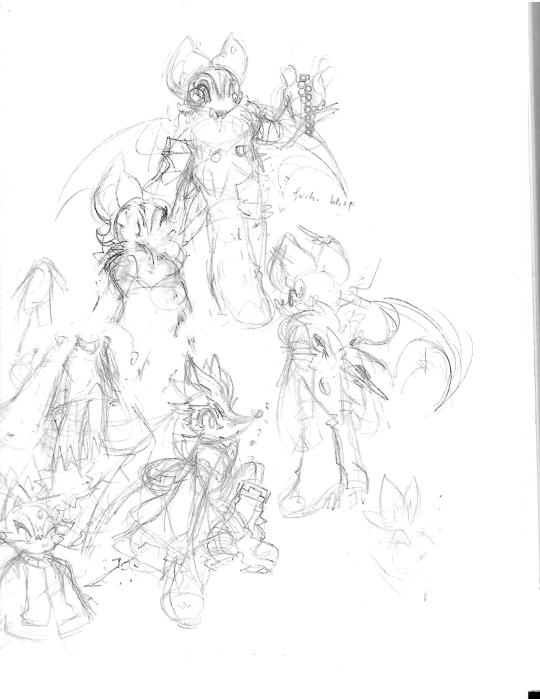
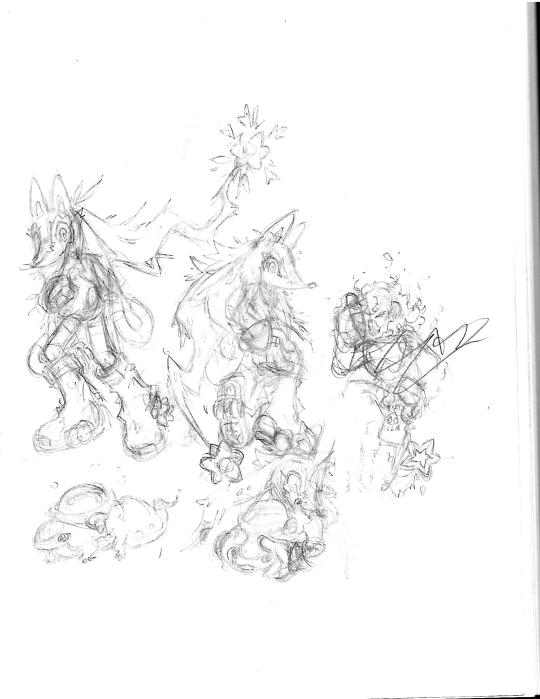

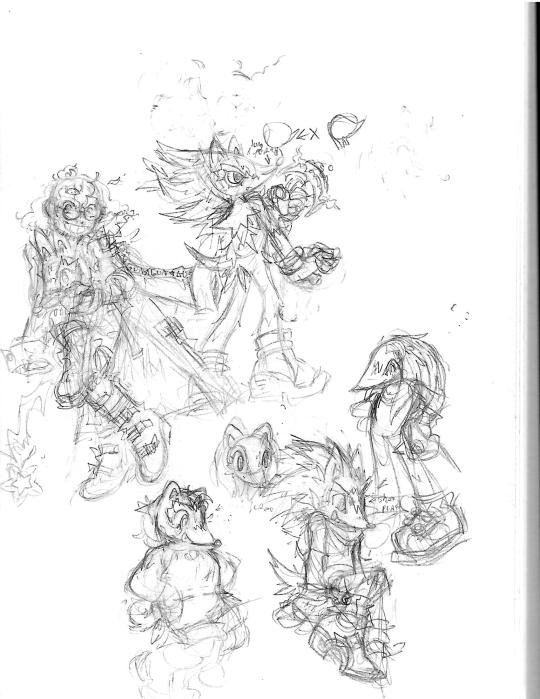
My'eah, some Sonic stuff I drew, playing with a different style!
Last 3 pages feature Terios, & the last page features Violet -- both are characters co-adored by @carnation-damnation !
#emeraldart#terios#knuckles the echidna#sonic the hedgehog#tails the fox#amy rose#rouge the bat#sth#blaze the cat#silver the hedgehog#shadow the hedgehog#sonic oc#chao#Idk how well it comes across but knuckles not only has his hat from the ova but also a vest with the same pattern as tikal's skirt#the general goal was to give everyone at least a bit of clothing bc the inconsistency in whether mobians wear full clothes or nothing#with little to no inbetween makes characters look overly simple or complicated to the point of straying stylistically too far#I didn't commit too hard here. Just gave people 1-2 accessories.#sonic has a neckerchief & pilot goggles bc I liked how it looked for boom & to reference that he ya know. had/has a plane.#I imagine he prolly wears them when he runs mostly bc he doesn't fly so often & it keeps the wind out of his eyes#I only gave tails a tool belt. felt that it leaves him a bit bare but looks overall okay.#I changed rouge to having this suit then realized i was literally just yoinking blaze's drip & felt bad :(#Silver has a gamer hoodie. I started doodling blaze with this cape she is sometimes mentioned as wearing but not shown in except concept ar#oh yeah there's also a tiny biolizard & i drew chao with paws. for fun#em.txt
58 notes
·
View notes
Text


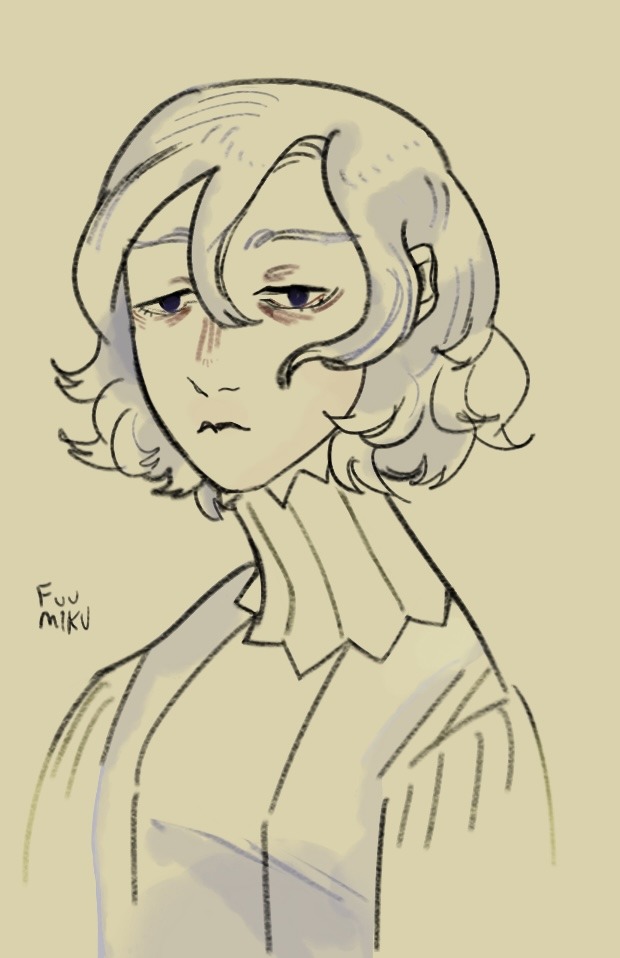
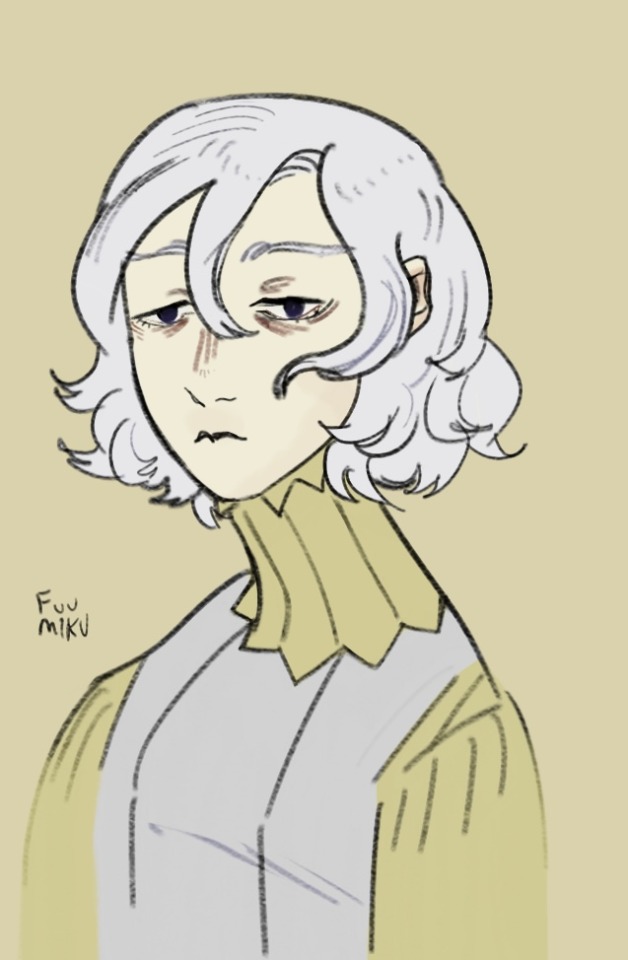
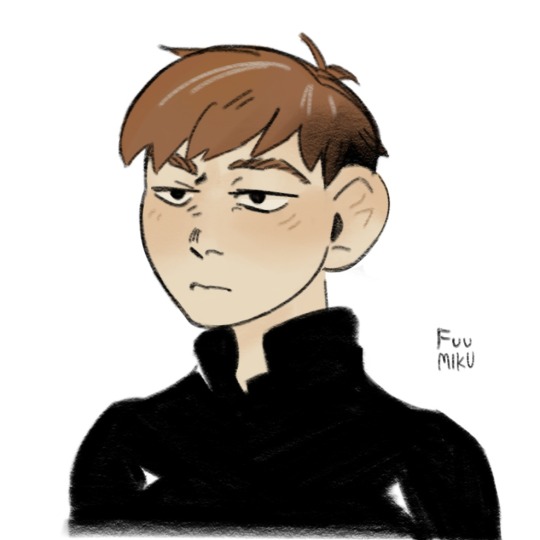
Happy new year!!
Some doodles I did today to unwind + test a lineart brush
#Dungeon meshi#mithrun#chikchuck tims#Laios please I swear you’re my fave I’ll draw you next Laios I promise Laios no don’t leave-#The mithrun one is so low resolution… Well it was supposed to be a quick doodle after all#Maybe i should post these sort of sketches I do more often#Coloring Chilchuck felt like therapy legit. Thank you dad#The mithrun one is a little fucked up but idk. It’s so aesthetic to me. Enjoy the many vers lol#Idk how long i’ll keep the new icon though#Hey my art style are you Chilchuck’s wife? Because I can’t help but feel like you left me for no reason#Jkjk my art style crisis usually stops whenever I just draw for the sake of it with no goal in mind lmao. Which is why I should do it more#Often!! I am so stubborn & stupid. Doing that shall be my New Year resolution ig#Y’all still here? Uhhh uh happy holidays good day!!
142 notes
·
View notes
Text
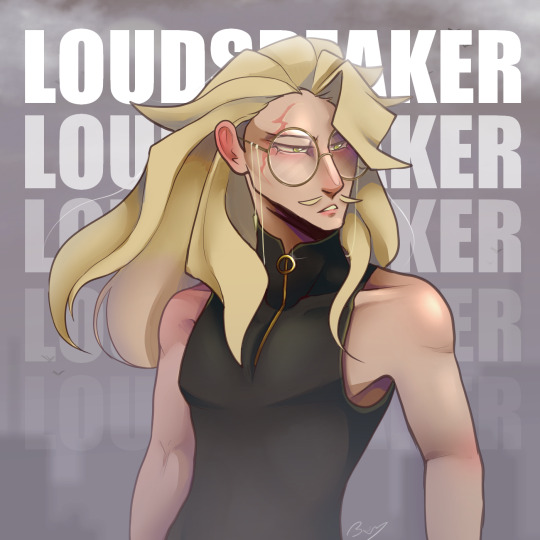
wildcat
#mmm#forgot how nice he was to draw#i was shocked to meet someone on PT the other day who had a Loudspeaker skin#i felt so famous#hizashi yamada#bnha#present mic#mha#villain!mic#loudspeaker au#if you play pt you might run into me ive been chilling on there more often lately#im usually around the mha area or the cafe#as mic or louis or the dog from the Dogs Used to Eat Me album cover that nobody recognises#i usually just sit around and wait to be complimented
267 notes
·
View notes
Text

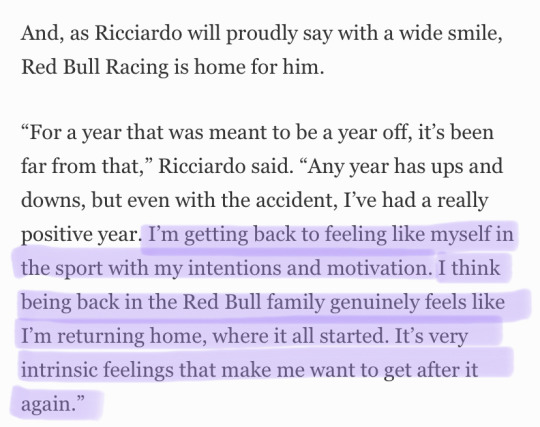

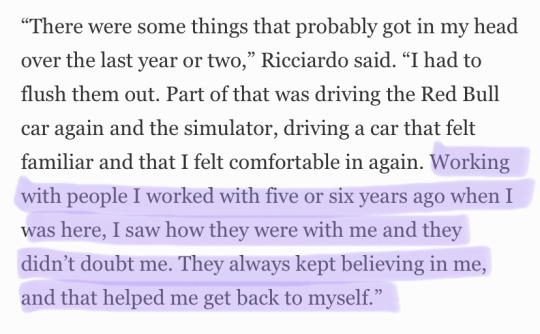

Back On The Formula 1 Grid, Daniel Ricciardo Wants To Prove He Can Win
#Daniel saw me miss his insane delusion-inducing interviews and said hold my beer#I think he’s talked so often about how redbull is home how going back has always felt right#and now to see him say that going back was possible because he didn’t burn bridges when he left#which I feel is him addressing the whole ‘redbull is doing him a charity by taking him back’ discourse#daniel ricciardo
95 notes
·
View notes
Text
Enough time has passed to where I think we can openly admit how WK has gone through seasonal rot within its previous 2 seasons and how the hype of Season 7 along with the generally positive reception is a really green flag for the show's quality.
#wild kratts#pbs kids#kratt brothers#martin kratt#chris kratt#pbs kids go#2d kratt brothers#2d martin kratt#2d chris kratt#because season 5 and 6 were.... not good to say the least#S5 took a hard plummet in quality after the Alaska special#Idk how to describe it but episodes felt more flat and basic more often than not despite there being several good ones in the mix too#S6 was slightly better but still felt more two-dimensional and basic and oddly oversaturated (and I don't just mean in the color palate)#I know Season 7's only been out for barely a year and we've only had 8-10 episodes released#But I do think that this season is substantially different than the previous two.#It feels a lot more experimental in its concepts whilst utilizing the show's strengths#Sometimes it works like with Clever the Raven or the Blue and Green special#Sometimes it doesn't like with the Mudskipper episode#But you can tell that they've some ideas in mind that you definitely wouldn't find in other seasons.#It genuinely makes me both curious and optimistic. Bc again it took 2 years to film this season.#There's definitely more time put into the writing process as earlier seasons.#I'm gonna hold some reservations until the season ends but it's shaping up to be pretty good so far.
33 notes
·
View notes
Text


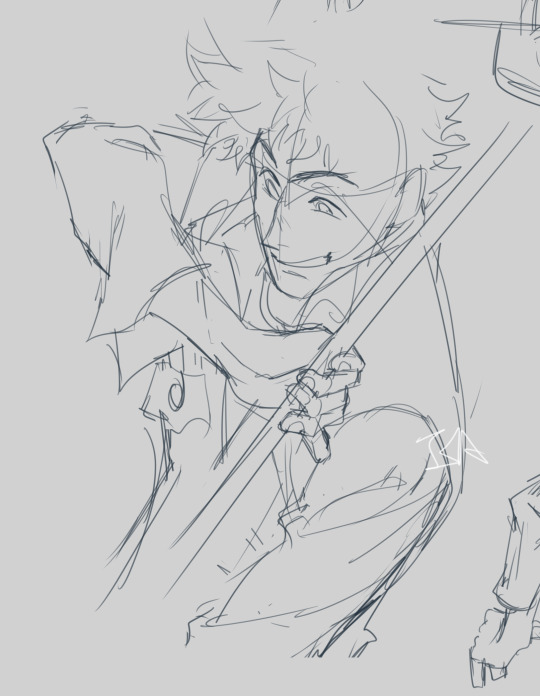
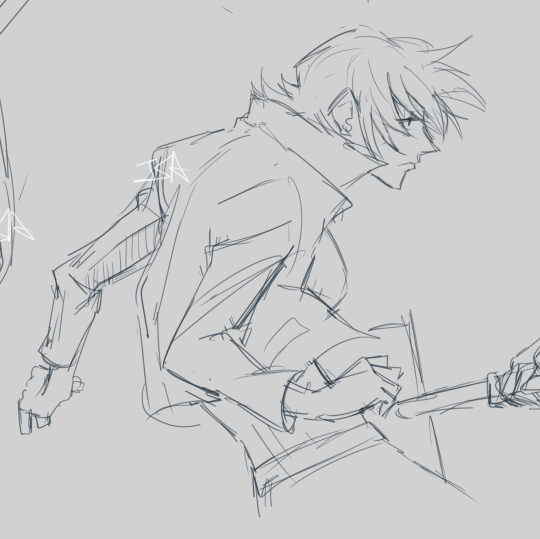
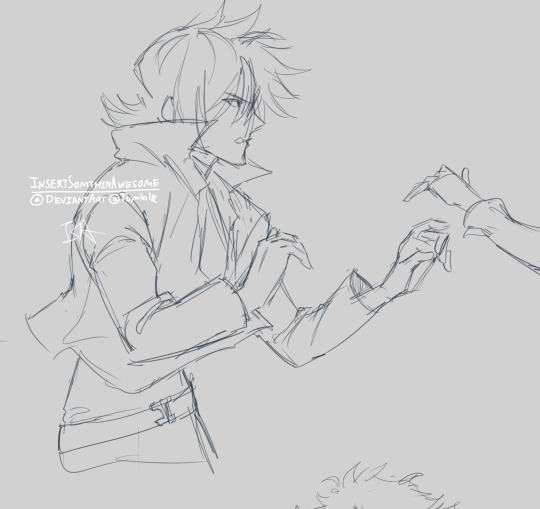

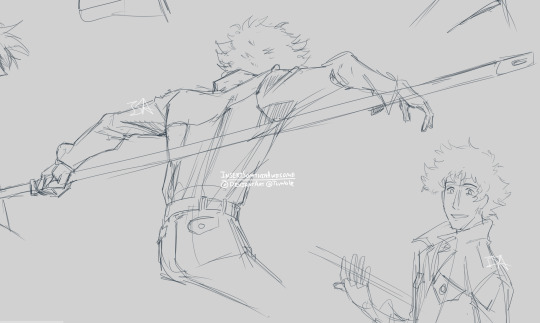



I can't normally share my studies because I'd very much need to get permission from the original creators I'm studying from to post them. But this time since it was a movie I can get away with it >:D
Nothing too exciting, I just pulled up a fight sequence from the Cowboy Bebop movie and drew frames that looked interesting.
It was fun for shutting my braincell off but still feeling like I was doing something to move forward :)
#InsertSomthinAwesome#isa's fanart#isa's art studies#June2023#Cowboy bebop#Spike Spiegel#Elektra ovirowa#I did not know she had a full name!! The more ya know :D#The desire to draw the titular “I love a woman” screenshot asdlkfjLSDKJGSDLJGLSDJGDSJ#Spike cowboy bebop#Elektra Cowboy Bebop#These were fun. Some of them are so bad. but like. it was for learning and I was choosing to let go of my perfectionism for this xD#IDK how often I'll share stuff like this. but I thought it might be neat. I felt like it so YOLO hope ya'll enjoy seeing some of the more#random behind the scenes stuff???? IDK that makes me sound so much more professional than i am xD#I need to watch this movie again sometime ^^;;
149 notes
·
View notes